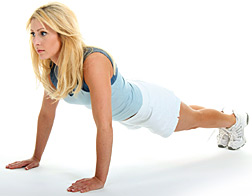- Push-ups. The wrong way: You should never have a dip or arch in your back or lock your arms. The right way: Arms should be underneath you and not locked, back parallel to the floor. Engage your "core" the entire time (squeeze your glutes and draw in your belly button).
- Walking lunges. The wrong way: When performing a lunge, extending the front knee past the front foot will cause injury at some point. The right way: When you are in a split stance, go straight down and do not let your front knee go past your foot.
- Leg press. The wrong way: Your knees should not be by your ears; that is not a position your knees are used to being in, especially under heavy weight. The right way: Keep 80 percent of the weight in your heels; press out and go a little past 90 degrees.

- Abs (crunches). The wrong way: Pulling the head up as you're doing a crunch. The right way: Relax your head and bring your shoulders off the ground, engaging your abs and rotating your hips to the ground.
- Squats. The wrong way: Knees coming forward over your toes. The right way: Perform this exercise as if you were sitting back on a chair and putting 80 percent of your weight on your heels. Then lean slightly forward so you won't fall back.
- Chest press. The wrong way: Lifting the weight using your back (high arch). The right way: Keep your back flat and relax your shoulders while lifting the weight.
- Cardio. This isn't really a specific exercise, but it still is something that lots of people do wrong in the gym: doing an hour or more of cardio. No, I'm not crazy; the only people who should do an hour of cardio are marathon runners. If you aren't planning to be in a marathon anytime soon, then I wouldn't do an hour. In fact, I recommend high-intensity training - for example, a 30-second sprint or quick walk followed by a 60-second jog, then another 30-second sprint, and so on; repeat that cycle about 10-12 times and you will get way more out of your cardio workouts in half the time. It works, trust me. Try it!
- Frequency: Being too zealous and working out 6-7 days a week for an hour or more each time. Your body needs rest and repair after a workout, so pace yourself and make exercise a healthy habit, not an obsessive one. If you don't take this advice, you will start to develop chronic injuries or just get burned out and stop working out, which is not what your exercise program was designed to achieve.
Start Off Right
And let's not forget about the right and wrong way to exercise in general. As I mentioned earlier, exercise is an art form and since most of us have not taken the time to master the proper techniques, we should get some expert advice prior to working out. Most gyms have personal trainers who will give you a free consultation and show you some basic machines and correct postures. Your doctor can also be a good source of information, particularly if they specialize in exercise and rehabilitation protocols. After all, you wouldn't just jump into a pool and expect to start swimming, right? Learn the right way to exercise from day one. When it comes to fitness goals, it isn't about how quickly you achieve them, because more often than not, going too quickly will end up being the slowest, most painful route. Exercise the right way, stay safe, and enjoy the journey.
4 Movements to Avoid When Exercising
- Using jerking motions, especially when lifting. Speed is fine when done appropriately, but you should always have fluid motion and proper form when performing any and all exercises; otherwise you could strain or even tear something.
- Using body parts not required for the exercise. Have you ever seen people doing biceps curls and rounding their shoulders or arching their backs? Those are just two of the big no-no's that can lead to injury.
- Locking out your knees or elbows. Never lock your joints when working out; keep them slightly bent so the weight will not be transferred to the joints.
- Arching your back. Picture someone on the barbell bench press, lifting a weight that is actually too heavy for them. Chances are that eventually, they will start arching their back. Sooner than later, that back is going to give out and they won't be able to exercise for days, weeks or even longer.
Chelsea Cooper, MPA, CPT, is certified by the National Academy of Sports Medicine as a personal trainer, performance enhancement specialist, and rehab and exercise specialist. To learn more, visit www.trainwithchelsea.com.

